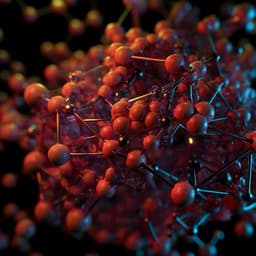
Engineering and Technology
Polymerizable rotaxane hydrogels for three-dimensional printing fabrication of wearable sensors
X. Xiong, Y. Chen, et al.
This groundbreaking study unveils conductive polymerizable rotaxane hydrogels (PR-Gel) that are not only stretchable and fatigue-resistant but also show remarkable capabilities as strain sensors for body motions and ECG signals. With impressive self-healing properties and skin adhesion, this innovation by authors from South China University of Technology is paving the way for next-generation wearable sensors.
~3 min • Beginner • English
Introduction
Hydrogels possess softness, wetness, responsiveness, and biocompatibility, enabling applications in wearable sensors, implantable bioelectronics, and electronic skins. However, conventional chemically crosslinked hydrogels are soft and brittle with poor energy dissipation, leading to irreversible damage and especially fatigue fracture under repeated stretching. Although tough hydrogels (e.g., double-network and nanocomposites) have improved tensile properties, most remain vulnerable to fatigue during cyclic loading. Designing hydrogels that combine high flexibility, resilience, toughness, and long-term stability for wearable sensors remains a significant challenge.
Literature Review
Slide-ring (SR) hydrogels based on polyrotaxane networks (e.g., PEG threaded with α-cyclodextrin) exhibit pulley effects from mobile junctions that disperse stress and yield high toughness and fracture resistance, outperforming covalently crosslinked gels. SR topological networks have enhanced elastomers and conducting polymers for bioelectronics, offering antifatigue performance and simultaneous conductivity and stretchability. Despite advances, SR hydrogels with excellent fatigue resistance tailored for sensors (e.g., strain sensors in electronic skin) are underexplored, and polyrotaxane synthesis with precise, low host coverage is complex and often inaccessible. Bile acids (e.g., cholic acid, lithocholic acid) are underutilized guest molecules for constructing topological networks in hydrogels. This work leverages precise host-guest recognition between acrylated β-cyclodextrin and a bile acid derivative to form polymerizable pseudorotaxane crosslinkers, aiming to replicate SR-like advantages without conventional polyrotaxane synthesis.
Methodology
Assembly and characterization of crosslinker: Acrylate-modified β-cyclodextrin (CD-AC) and ethylene glycol lithocholate-derived diacrylate (LCA-AC) were synthesized via acryloyl chloride modification. A polymerizable pseudorotaxane crosslinker was assembled through host-guest recognition between β-CD (host) and LCA units (guest). Solid-state complexation was verified by powder XRD: characteristic diffraction peaks of LCA-AC disappeared in the complex, unlike a physical mixture. The association constant in EG/water was measured by ITC (Ka ≈ 2.36 ± 0.18 × 10^6 M^-1). To enable NMR observation, a water-soluble LCA-AC-PEG (PEG2000) analogue was synthesized; NOESY 2D NMR showed NOE correlations between LCA methyl protons and β-CD interior H3/H5, confirming inclusion. ITC for LCA-AC-PEG/CD-AC in water gave Ka ≈ 6.09 ± 0.6 × 10^3 M^-1. Additional XRD of β-CD with LCA-AC-PEG showed β-CD sliding over PEG segments and specific recognition of LCA units.
Hydrogel fabrication: The CD-AC/LCA-AC (1:1 mol) pseudorotaxane crosslinker was photocured with acrylamide (Am) in a binary solvent (ethylene glycol/water) with choline chloride (ChCl) to form conductive PR-Gel. For comparison, chemically crosslinked MBA-Gel (N,N'-methylenebisacrylamide) and CD-Gel (CD-AC as crosslinker) were prepared with the same recipe except crosslinkers. Optimal Am concentration was 40 w/v% with 0.5 mol% pseudorotaxane crosslinker; higher Am (50 w/v%) caused LCA-AC precipitation.
Mechanical testing: Uniaxial tensile tests (100 mm/min, 1 mm thickness) at -20, 25, and 60 °C; cyclic loading-unloading at various strains including up to 500% and long-term cycling to 500 cycles at 300% strain; compression tests (Instron 5967, 20 mm/min) and puncture tests (texture analyzer, 20 mm/min) with needles of 1 and 4 mm diameter; SEM of freeze-dried gels; SAXS of stretched hydrogels to assess anisotropy and network homogeneity.
Adhesion and self-healing: Lap-shear tests on nitrile glove, glass, silicone rubber, aluminum, and pigskin; rheology with alternating strain sweeps (1% and 500%) to probe network recovery; qualitative self-healing by rejoining cut samples (color-contrasted halves).
Electrical characterization: Ionic conductivity via EIS (Nyquist extrapolation); strain sensing characterized by relative resistance change (ΔR/R0) versus strain and gauge factor calculation; stability after one month storage; durability under 100 cycles at 300% strain; demonstration of stretch-break-heal electrical recovery in an LED circuit.
3D printing: Digital light processing (DLP) 3D printing using LAP photoinitiator and tartrazine light absorber; layer height 50 µm, exposure 2.88 s per layer; fabrication of high-resolution PR-Gel sensors and electrodes; ECG acquisition using 3D-printed PR-Gel electrodes with wireless data transmission.
Materials characterization techniques included NMR (1H, 13C, NOESY), HRMS, HPLC (for CD-AC), XPS (CD-AC), and standard mechanical/electrochemical instrumentation as specified.
Key Findings
- Strong host-guest complexation: CD-AC and LCA-AC form a polymerizable pseudorotaxane crosslinker with Ka ≈ 2.36 × 10^6 M^-1 in EG/water; NOESY confirmed inclusion of LCA in β-CD cavities for the PEGylated analogue.
- Enhanced mechanical performance: Increasing Am from 20 to 40 w/v% raised fracture stress from 6.8 to 78.1 kPa and work of rupture from 29.9 to 270.7 kJ/m^3. Optimized PR-Gel (40 w/v% Am, 0.5 mol% crosslinker) stretched up to 830% and outperformed MBA-Gel and CD-Gel in tensile strength and elongation.
- Temperature tolerance: After 10 h storage, stretchability remained high: 650% at -20 °C (vs 830% at 25 °C) and 790% at 60 °C, indicating anti-freezing and heat tolerance.
- Fatigue resistance: Loading-unloading showed no hysteresis at 100–300% strain and only minor hysteresis at 400–500%. At 300% strain, five cycles overlapped with dissipation energies 0.82–1.11 kJ/m^3 and resilience >97%. No significant hysteresis even after 500 cycles at 300% strain.
- Compression and puncture resistance: 95% compression with rapid shape recovery; umbrella-like puncture deformation with displacement up to 25 mm using a 1 mm needle; cuts with a sharp blade left no scars after release due to topological network behavior.
- Network homogeneity: SAXS patterns remained isotropic up to 500% strain, consistent with mobile junctions allowing chain passage and entropy maximization.
- Adhesion and self-healing: Lap-shear adhesion strengths to diverse substrates ranged ~4.5–6.0 kPa, enabling repeatable skin adhesion without residue. G' and G'' recovered rapidly after alternating large-amplitude oscillatory damage, and cut samples self-healed at ambient conditions to withstand tensile deformation.
- Conductivity and sensing: Ionic conductivity 0.93 S/m at room temperature and 0.54 S/m at -20 °C. Gauge factor (GF) ≈ 3.91 (0–200% strain range), 6.43 (200–400%), and 8.53 (400–500%). Minimal electrical hysteresis even at 500% strain; after one month, GF decreased negligibly (~1.1% in 200–400% range). Under 100 cycles at 300% strain, resistance signals were highly reproducible with stable baseline.
- Wearable sensing: PR-Gel sensors accurately captured finger bending angles, pressing, throat swallowing, wrist, and elbow movements with synchronized signal changes and high repeatability.
- 3D printing: DLP-fabricated PR-Gel sensors exhibited high resolution and complex geometries, adhered directly to skin, and provided sensitive responses during hand motions. 3D-printed PR-Gel electrodes recorded stable, real-time ECG signals comparable to commercial electrodes.
Discussion
The study addresses the challenge of fatigue fracture in hydrogel-based wearable sensors by introducing topological networks with mobile junctions via polymerizable pseudorotaxane crosslinkers. The β-cyclodextrin–bile acid interactions create movable crosslinks that redistribute stress along polymer chains, resulting in exceptional elasticity, toughness, and antifatigue properties while maintaining isotropic network structure under large deformation. The binary EG/water solvent with ChCl endows anti-freezing, moisture retention, and ionic conductivity, enabling reliable sensing across temperatures. Electrical measurements corroborate mechanical resilience: minimal hysteresis, wide dynamic range with high GF, and long-term stability support practical sensor use. Integration with DLP 3D printing demonstrates rapid, customizable fabrication of complex, skin-adhesive sensors and functional electrodes capable of real-time ECG monitoring. Collectively, the PR topological network provides a robust platform for flexible, durable, and sensitive wearable hydrogel electronics without the synthetic complexity of traditional polyrotaxanes.
Conclusion
This work introduces conductive polymerizable rotaxane hydrogels (PR-Gel) formed by photocuring acrylated β-cyclodextrin–bile acid pseudorotaxane crosslinkers with acrylamide in EG/water with ChCl. Mobile junctions in the topological network yield extraordinary stretchability (up to 830%), superior fatigue resistance (stable after 500 cycles at 300% strain), anti-freezing properties, self-adhesion, and self-healing. PR-Gel-based sensors show high sensitivity and stability for monitoring diverse human motions, and DLP 3D printing enables high-resolution, complex, skin-adhesive devices, including electrodes that acquire real-time ECG signals. The approach offers a practical alternative to conventional polyrotaxane architectures for 3D-printable, fatigue-resistant flexible electronics. Future work could explore broader host–guest chemistries, long-term biocompatibility and wear studies, integration with multifunctional electronics, and scalable manufacturing for clinical and consumer applications.
Limitations
- Solubility constraints: LCA-AC has extremely low solubility in water, necessitating an EG/water solvent system and preventing direct 1H NMR characterization; PEGylated analogues were used for NMR confirmation.
- Formulation window: Higher monomer concentrations (e.g., 50 w/v% Am) led to LCA-AC precipitation, limiting processing ranges.
- Adhesion strength: While adequate and repeatable for skin attachment, lap-shear adhesion (≈4.5–6.0 kPa) is lower than strongly adhesive hydrogel systems, which may limit applications requiring high interfacial toughness.
- Biological evaluation: The study demonstrates on-skin sensing but does not include comprehensive biocompatibility, irritation, or long-term wear studies.
- Environmental robustness beyond temperature: Humidity cycling, sweat, and chemical exposure effects were not extensively reported.
Related Publications
Explore these studies to deepen your understanding of the subject.







